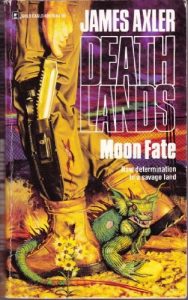 Apparently, the Deathlands series is completed, at 75 books, as of sometime last year. That’s kind of cool, because it implies that I might ever finish[1]. Not a habit I’m used to, what with Marvel comics that have been published continuously since 1961 with no end in sight.
Apparently, the Deathlands series is completed, at 75 books, as of sometime last year. That’s kind of cool, because it implies that I might ever finish[1]. Not a habit I’m used to, what with Marvel comics that have been published continuously since 1961 with no end in sight.
I’m not sure that has any special relevance, but I learned it while doing research into the author of Moon Fate. (James Axler is a farm name, you see, assigned to any number of actual writers in the series, but not a real person in his own right.) The sad reason for this research was that there was a tonal shift so drastic, I briefly hoped there had been a change of the usual author to explain it. Here’s an implausible number of words about that.
Weirdly, even now, I can’t tell if I’m being unrealistic. In thumbnail, Ryan Cawdor is returning from the events of Chill Factor to rejoin his friends, but due to a series of the kind of tragic event that is so typical in a post-apocalyptic hellhole, they end up split once more, with he and his girlfriend captured by vengeful mutant “stickies”, so called because they are part of a common lineage in the Deathlands whereby their arms are covered with incredibly strong octopus-like suckers, strong enough to strip flesh right off any “norms” they might come in contact with.
And here is where problem one crops up. Normally stickies are, in addition to being strong and violent death machines, quite lowly ranked on the intelligence scale. Which is fine, killer mutants are a staple of any nuclear holocaust. But they were lead by an especially intelligent throwback to humanity, who of course was a figure from Ryan’s past. I don’t mind that they had a bad time together and the stickie wanted revenge. I mind that, after going to all the trouble of making him a leader who was intelligent and strong-willed enough to organize his troops instead of the usual ravening hordes, the story still treated them as mindless enemies. A story where the mutants could also be human would have been much cooler.
In any case, not enough to put me off the story, but then there was a rape scene in which a female stickie took Ryan into her quarters for to satisfy her carnally. And… I mean, there was only the one mostly human throwback, so I’m not saying I have a problem with the run of the mill mutant being a grotesquerie. And if the rape scene had been reversed, with lead female character Krysty Wroth being the victim, that wouldn’t have been any better, for all kinds of reasons. Still, the scene where Ryan was being forced to perform oral sex was just relentlessly anti-female, in a way I have thusfar thought this series was better than. And like I said, I read over the caveats and feel like I’m being way too sensitive about this; because yes the scene could have been left out entirely, but once you accept its presence, I can’t really see anything unrealistic about it. All the same, it felt skeevy, and I hope it doesn’t happen again.
Third, not that I much care about this, and especially in comparison to the other two, but I have no earthly idea what the title had to do with anything at all.
Anyway, leaving aside those complaints, the book was at least a nice change of pace from the standard “teleport somewhere, right a wrong, move on” template the series quickly fell into. I mean, yes, that is technically exactly what happened, but the trappings were all different, what with resuming from a split party, visiting friends, and staying in town for months rather than days or hours.
[1] Given that this book is #16, I’m already 20% of the way through!
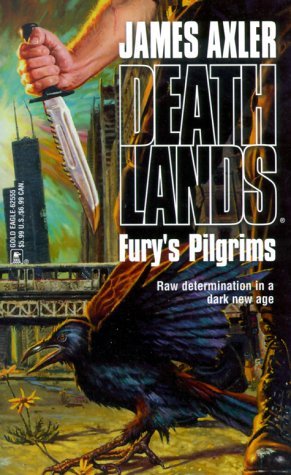 Did I mention that the Deathlands series is over, as of earlier this year? Probably. It’s just so weird to me that this thing has an ending, 30 years after it started. Especially when I compare to my infinite and infinitely expanding Marvel comics thing, you know? I mean, I’m still only to 1992 here, so it’s not like I’m in any danger of running out, it’s just strange.
Did I mention that the Deathlands series is over, as of earlier this year? Probably. It’s just so weird to me that this thing has an ending, 30 years after it started. Especially when I compare to my infinite and infinitely expanding Marvel comics thing, you know? I mean, I’m still only to 1992 here, so it’s not like I’m in any danger of running out, it’s just strange. Apparently, the Deathlands series is completed, at 75 books, as of sometime last year. That’s kind of cool, because it implies that I might ever finish[1]. Not a habit I’m used to, what with Marvel comics that have been published continuously since 1961 with no end in sight.
Apparently, the Deathlands series is completed, at 75 books, as of sometime last year. That’s kind of cool, because it implies that I might ever finish[1]. Not a habit I’m used to, what with Marvel comics that have been published continuously since 1961 with no end in sight.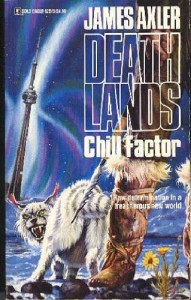
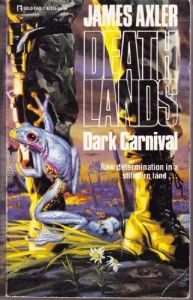
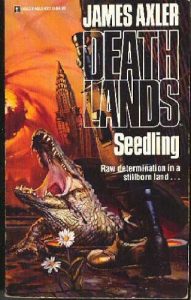 Assuming you haven’t been here long (and are unwilling to click through the Deathlands tag): post-apocalyptic 22nd Century gun porn with teleporters and whiffs of Seven Samurai, in episodic format, series approximately 100 books in length. Okay? Okay.
Assuming you haven’t been here long (and are unwilling to click through the Deathlands tag): post-apocalyptic 22nd Century gun porn with teleporters and whiffs of Seven Samurai, in episodic format, series approximately 100 books in length. Okay? Okay.

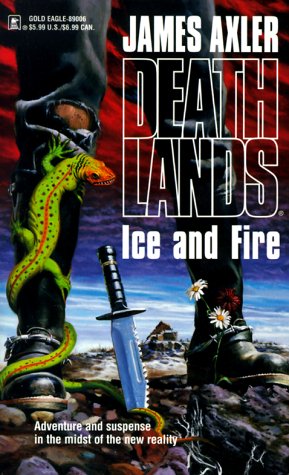 I’m reading too many of these, and they are too similar, for much in the way of in depth reviews. So I think if you are interested at all, you’ve got the premise settled in your head by now, and I can just go with sense impressions, unless something vital changes. So, here’s what’s going on in
I’m reading too many of these, and they are too similar, for much in the way of in depth reviews. So I think if you are interested at all, you’ve got the premise settled in your head by now, and I can just go with sense impressions, unless something vital changes. So, here’s what’s going on in